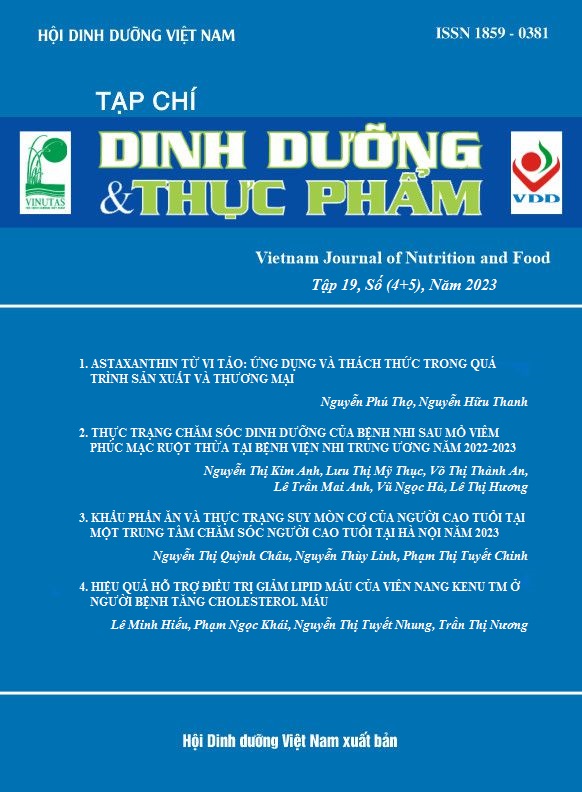THE FEEDING PRACTICES OF MOTHERS WITH CHILDREN AGED 6-23 MONTHS VISITED THE CLINIC FOR NUTRITION COUNSELING AND VACCINATION, SCHOOL OF PREVENTIVE MEDICINE AND PUBLIC HEALTH
Main Article Content
Abstract
Aims: To describe the child-feeding practices of mothers with 6-23 months old children at the nutrition counselling and vaccination clinic, School of Preventive Medicine and Public Health, from 2022 to 2023.
Methods: This is a cross-sectional descriptive study, data on feeding practices were collected from 394 pairs of mothers and their children aged 12-23 months who came to the clinic for consultation. and vaccination at the clinic from January 2022 to March 2023.
Results: The percentage of children being breastfed was 31%, there was a statistically significant difference in the rate of breastfeeding among age groups (p<0.001); There was a statistically significant difference in the number of meals between age groups (p<0.001); Children were relatively able to use a variety of food groups such as food, milk, other groups of vegetables and fruits, and fats, the rate of using sweets and confectionery is 43.9%; rate of using salted seasoning 62.4%.
Conclusion: The rate of children being breastfed was still low, many children were breastfed by bottles with nipples, and children were rarely used to a variety of food groups such as eggs, meat, and legumes.
Keywords
Nurturing practices, children 6-23 months old
Article Details
References
2.Viện Dinh dưỡng quốc gia -BộY tếvà Tổng cục Thống kê. Tổng điều tra dinh dưỡng 2019 -2020. Trung tâm giáo dục truyền thông dinh dưỡng, 2021.
3.World Health Organization and U. N. C. Fund (UNICEF). Global Strategy for Infant and Young Child Feeding.World Health Organization, 2003. Access: 20May,2023. [Online]. Available at: https://apps.who.int/iris/handle/10665/42590
4.Unicef for every child, Tổng cục Thống kê, và United Nations Population Fund. Điều tra các mục tiêu phát triển bền vững vềtrẻem và phụnữViệtNam 2020 -2021. tháng 12/2021.
5.Lê Bạch Mai, Lê Danh Tuyên, và ĐỗThịPhương Hà, Các phương pháp điều tra và đánh giá khẩu phần. NxbY học, Hà Nội. 2017.
6.World Health Organization and Unicef for every child. Indicators for assessing infant and young child feeding practices. WHO Document Production Services, 2021.
7.Unicef for every child and World Health Organization. Global Breastfeeding Scorecard 2021: Protecting Breastfeeding Through Bold National Actions During The Covid-19 Pandemic And Beyond.2021. [Online]. Available at: unicef.org/breastfeeding
8.UNICEF Press Centre | UNICEF calls for the narrowing of „breastfeeding gaps‟ between rich and poor worldwideUNICEF Europe andCentral Asia. https://www.unicef.org/eca/press-releases/unicef-calls-narrowing-breastfeeding-gaps-between-rich-and-poor-worldwide (Access6/20/2023).
9.E. Asimaki, M. Dagla,A. Sarantaki, and M. Iliadou. Main Biopsychosocial Factors Influencing Breastfeeding: a SystematicReview, Maedica (Bucur) 2022; 17(4):955–962. doi: 10.26574/maedica.2022.17.4.955.
10.Unicef for every child. Improving Young Children‟s Diets During the Complementary Feeding Period.Unicef for every child, 2020.
11.ChaithaweesupP, BoonrusmeeS, JaruratanasirikulS, PuwanantM, Chimrung,Kand SriplungH. Infant and Child Feeding Index (ICFI) and NutritionalAssessment in 6-12-Month-Old Infants: A Study inSouthern Thailand.2022, DOI: 10.15226/jfs.2022.001190.
12.Champion C and SeidelR. Engaging the Private Sectorto Improve Access to Fortified Complementary Foods: Moving from the „If‟ to the „How‟”, 2015.
13.KhandpurNet al. Ultra-Processed Food Consumption among the Paediatric Population: An Overview and Call to Action from the European Childhood Obesity Group. ANM. 2020;76(2):109–113.doi: 10.1159/000507840.
14.World Health Organization. Regional Office for Europe. Commercial foods for infants and young children in the WHO European Region: a study of the availability, composition and marketing of baby foods in four European countries. World Health Organization. Regional Office for Europe, WHO/EURO:2019-3588-43347-60811, 2019. Access: 4/08/2023. [Online]. Available at: https://apps.who.int/iris/handle/10665/346581
Similar Articles
- Trong Hung NGUYEN, Thi Thuy Hien NGUYEN, Khanh Linh DANG, Thi Thao NGUYEN, Hoang Duy Nam LE, Khac Tuan Anh HOANG, Hoai Thu VU, Thuy Linh TA, Huong Duong PHAN, Hoang Hiep PHAN, NUTRITIONAL STATUS AND SOME RELATED FACTORS OF TYPE 2 DIABETES PATIENTS AT THE CENTRAL ENDOCRINOLOGY HOSPITAL IN THE PERIOD 2015 – 2025: A SCOPING REVIEW , Vietnam Journal of Nutrition & Food: Vol. 21 No. 6 (2025)
- Xuan Bich TRUONG, Van Phu PHAM, NUTRITIONAL STATUS AND FACTORS ASSOCIATED WITH OVERWEIGHT AND OBESITY IN OUTPATIENTS WITH TYPE 2 DIABETES AT NGUYEN TRI PHUONG HOSPITAL, 2023 , Vietnam Journal of Nutrition & Food: Vol. 20 No. 5 (2024)
- Dai Duc Anh MAI, Thi Phuong DONG, Thi Bich Nga VU, Thi Lan Phuong VU, Thuy Linh NGUYEN, Hoang Thien Tam NGUYEN, Trong Hung NGUYEN, FACTORS ASSOCIATED WITH NUTRITIONAL STATUS OF INPATIENTS WITH TYPE 2 DIABETES AT HANOI MEDICAL UNIVERSITY HOSPITAL, 2020 , Vietnam Journal of Nutrition & Food: Vol. 19 No. 3E (2023)
- Thi Bich Thuy TRAN, Thi Huong Lan NGUYEN, NUTRITIONAL STATUS AND SOME FACTORS RELATED TO OVERWEIGHT-OBESITY IN TYPE 2 DIABETES PATIENTS UNDERGOING IN-PATIENT TREATMENT AT THE DEPARTMENT OF NEPHROLOGY-ENDOCRINOLOGY, VIET TIEP FRIENDSHIP HOSPITAL IN 2023 – 2024 , Vietnam Journal of Nutrition & Food: Vol. 20 No. 5 (2024)
- TS Thi Huong Lan NGUYEN, Thanh Tien NGUYEN, My Phuong LE, Thai Am NGUYEN, NUTRITIONAL STATUS AND RELATED FACTORS OF INPATIENTS WITH TYPE 2 DIABETES AT SAINT PAUL GENERAL HOSPITAL IN 2023 , Vietnam Journal of Nutrition & Food: Vol. 21 No. 3 (2025)
- Thi Huong LE, Nguyễn Thị Đính, Thi Phuong DUONG, Hai My HOANG, Thi Thu Lieu NGUYEN, TÌNH TRẠNG DINH DƯỠNG CỦA BỆNH NHÂN ĐÁI THÁO ĐƯỜNG TÝP 2 VÀ MỘT SỐ YẾU TỐ LIÊN QUAN TẠI KHOA NỘI BỆNH VIỆN ĐẠI HỌC Y HÀ NỘI NĂM 2016 , Vietnam Journal of Nutrition & Food: Vol. 13 No. 4 (2017)
You may also start an advanced similarity search for this article.


